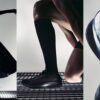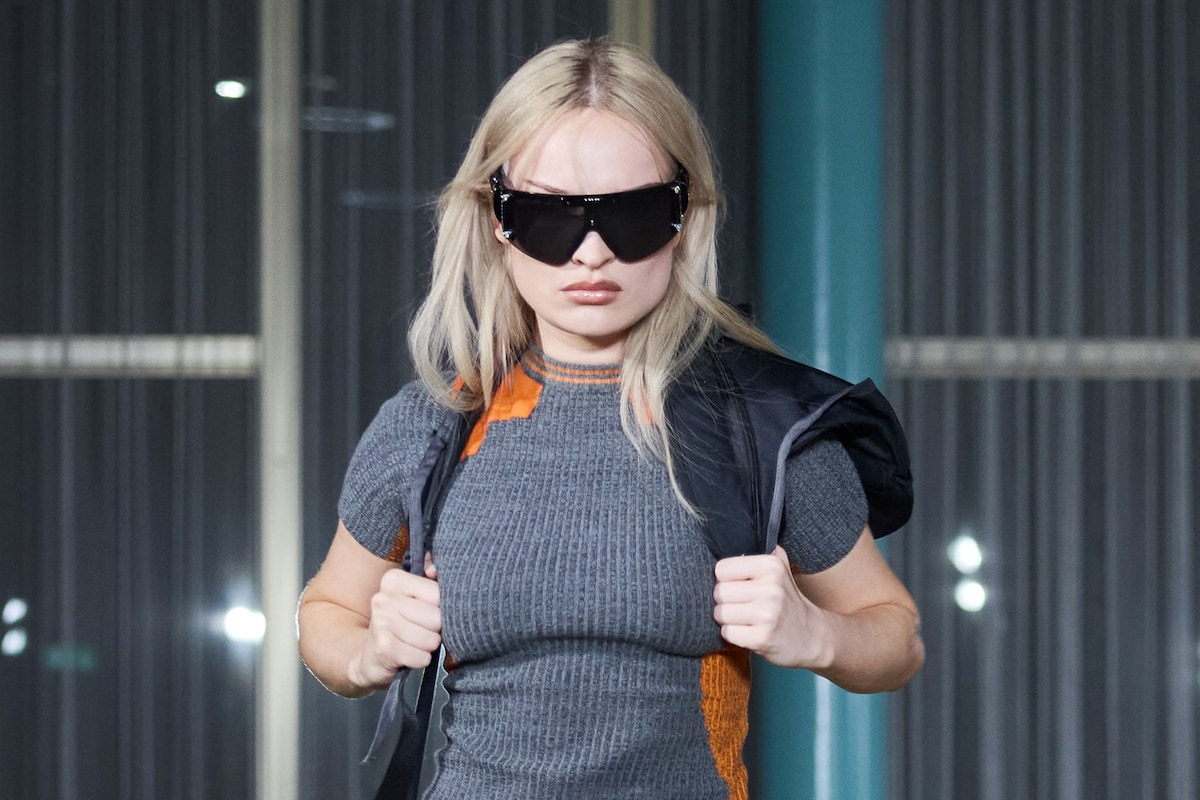
Rewrite
Berlin Fashion Week SS26 street style50 Images
Much has been made of Berlin Fashion Week’s ascent in the last couple of years. With Fashion Council Germany – along with the help of the German state – now committed to pumping €4 million a season into the shows, there’s been a renewed interest in the bi-annual fashion week, which has steadily been making its mark over the past few seasons.
A main draw for a lot of attendees is Intervention, a curated day of shows from the Berlin-based agency Reference Studios. When speaking to agency founder Mumi Haiati about Intervention drawing guests to Berlin, the Reference boss is thankful, but sees the operation as much bigger than himself. “I’m flattered, but I also feel like this was exactly the mission,” he says. “For us it was important we create something that can be relevant for the world, to build an identity for Berlin, without being too homogenous. The city of Berlin came to us for that challenge.” And working alongside Germany’s governing fashion body, Reference and the FCG now have “a deep understanding of each other and a mutual goal: to put creativity first”, according to Haiati.
Outside of Intervention, the entire BFW schedule is packed full of young talent, like Central Saint Martins grad Andrej Gronau, who presented his sophomore collection last week; Berlin stalwart Sia Arnika, who continues her exploration into It-girl style; and Richert Beil, who presented a refined collection with a laser-like focus on craft. For all those and more, these were the best shows to come out of Berlin Fashion Week SS26.
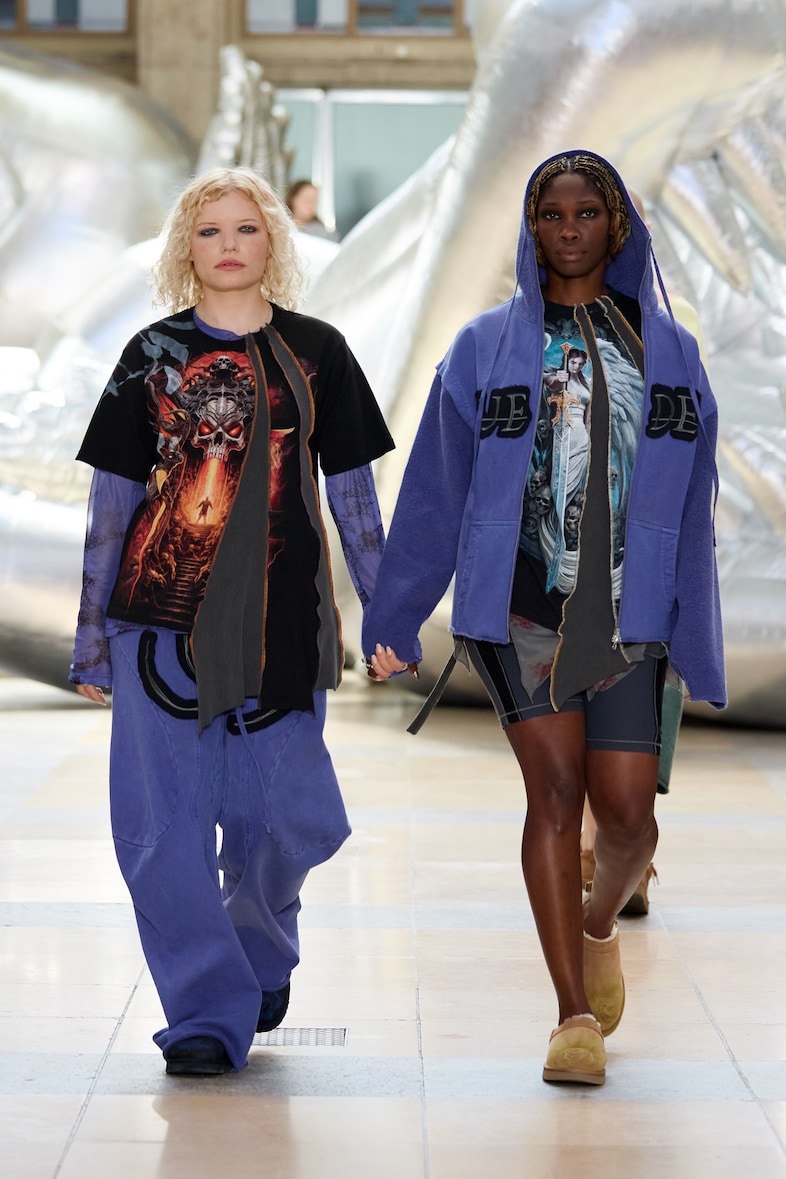
As the opening act of this season’s Intervention, LUEDER SS26 introduced guests to the Palais am Funkturn, an impressive mid-century events space built by Bruno Grimmek and Werner Düttmann in 1957. One of the building’s main spaces – a cavernous ballroom with towering stained glass windows – was the perfect venue for Marie Lueder’s newest designs, which often feel ecclesiastic in their references. After AW25’s sojourn into sexier territory, Lueder returned to the more overtly medieval inspirations of past seasons – but SS26 was far from a regression. Inspired by the story of St George and the Dragon, the collection reimagined “ancient archetypes through the lens of present-day resistance, transformation, and psychic armour”. A stirring performance from Roman Ole began proceedings, then on the runway, the dragon was recast as a giant inflatable Venus flytrap, bringing the allegory into the domestic realm, while models walked the church-like space in diaphanous gowns and serf-coded knits. Piercing dragon eyes appeared on bikini bra cups, Hawaiian shirts were splattered with bleach and a collaboration with Ugg saw models walk the space in its ankle-high sheepskin boots.
Ottolinger Resort 202638 Images
After years and years at Paris Fashion Week, this season Berlin finally enticed Christa Bösch and Cosima Gadient to show up for their home city. Also a part of Reference Studios’ Intervention format, Ottolinger’s BFW catwalk was actually a Resort collection rather than SS26, suggesting they’ll probably pop back to Paris when the time comes this September. Despite that though, the duo left nothing on the table in the German capital, enlisting Kim Petras to open their Heidi collection, an ode to the cool, older sisters everywhere.
“Being the cooler older sister isn’t about being perfect,” read notes placed on seats at the show. “It’s about having lived – loved too hard, fallen harder, found her way back, and doing it all in a way that makes you believe you can too. She’s the one who broke the rules first – so you wouldn’t have to be afraid of breaking them.” Right on time, (or just a little behind schedule) rule-breaking pop star Petras opened in orange and grey knitted hotpants, her viral stomp very likely to have already graced your For You Page. Glimpses of an upcoming Nike collaboration (expected 2026) were layered under slinky cutout dresses, while the bulky, distressed leather jackets were a clear standout.
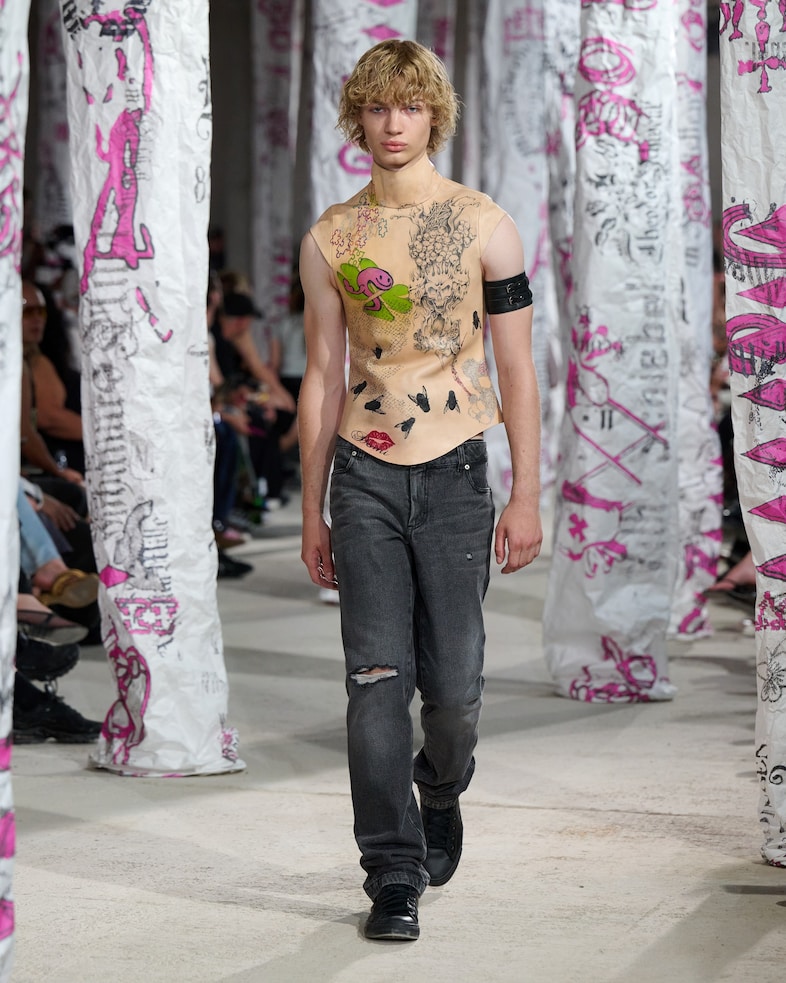
After an AW25 collection that leaned too heavily on of-the-moment, “indie sleaze” aesthetics, SF1OG was back on form with an offering inspired by “the fragile terrain of romance, walking the fine line between longing, obsession, and emotional decay.” Held in an active building site a stone’s throw from the famous Kurfürstendamm designer district, set designer John Andrews hung fabric-covered pillars from the ceiling, ones you had to deftly navigate to find your seat. The claustrophobia continued as models weaved their way through the hanging ornaments down the narrow runway, often centimetres from the onlooking guests. The show space had been designed to mimic the awkward intensity of teenage romance, and so had the clothes: an opening leather jacket look came torn and tattered, Sacred Heart motifs came black and emo, while ripped jeans and raw hems communicated an angsty, rebellious flare. Elsewhere, leather corsets colour-matched to their models’ skin were covered in excessive, angsty scribbles, as if a troubled teenager had taken a Sharpie to their bedroom wall, and arrows shot by Cupid rested as accessories strapped to models’ heads.

Andrej Gronau SS2619 Images
Central Saint Martins graduate Andrej Gronau presented his debut last season, a collection full of colourful knits in bold colours with a recurring star motif. For SS26, everything was elevated but still rendered in Gronau’s signature youthful style. A men’s white top with twisted ruching opened the show, and below were trousers with a drop-waist effect caused by some block panelling around the waist. A checked duster coat with cable knit legging followed, then pleated tennis skirts and cute cable knits. A red and white gingham print became a touchstone in the collection, cropping up on jackets, boxer shorts and a peplum skirt. Backstage after the show, Gronau revealed that the collection, Alpine Fiction, was inspired by an impromptu trip to the Alps, which made a lot of sense considering the subtle Bavarian flavour running through. Reimagining folk heritage “through a surreal, contemporary lens”, lederhosen were re-envisioned as roomy board shorts, narrow scarves looped around models’ necks and pussy-bows dotted on cashmere and slacks.
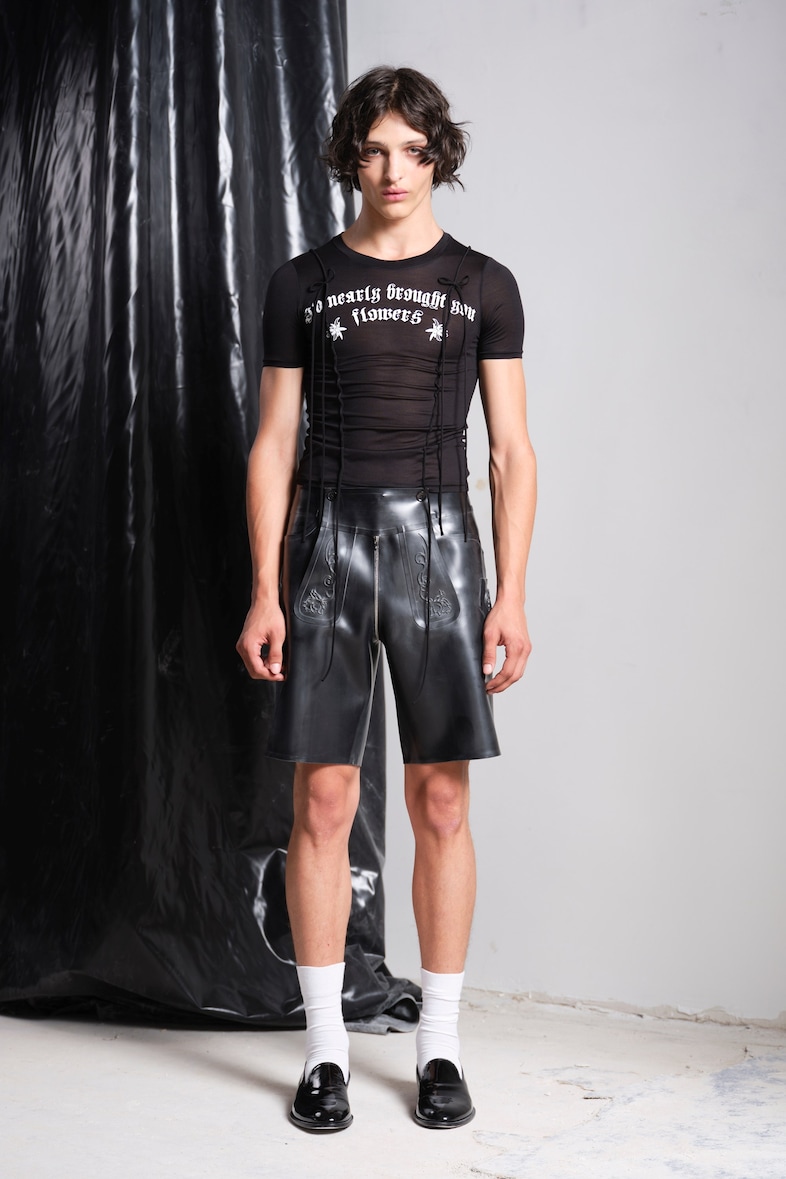
Richert Beil SS2615 Images
For their SS26 show, designers Jale Richert and Michele Beil brought guests to their new studio, a 135-year-old renovated pharmacy in Berlin’s Kreuzberg. With dusty floorboards and a very intimate seating plan, the show was a “reflection on beginnings and endings, on transformation and on the responsibility of creating something with meaning” according to show notes. Made during their move to the new space, Milieuschutz the collection is named after Milieuschutz the concept, a type of planning protection that some neighbourhoods have to protect their social character (not incidentally, Richert Beil’s new Kreuzberg studio is protected by Milieuschutz.) “The title itself references the legal protection of neighborhoods, but here it becomes a metaphor,” said the designers. “For protecting values, methods, and ideas that are at risk of being lost in the pace and surface of today’s fashion system.”
Though it may seem an arcane concept to non-Germans, on the runway this was translated to a focus on craft, or as Richert and Beil put it “keeping the poetry – in fabric, in form, in process – while evolving structure and clarity.” By far the label’s most technically impressive collection to date, the tailoring was of the highest level, latex coats bounced like supple leather, and graphics and logos were used in a considered and tasteful way.
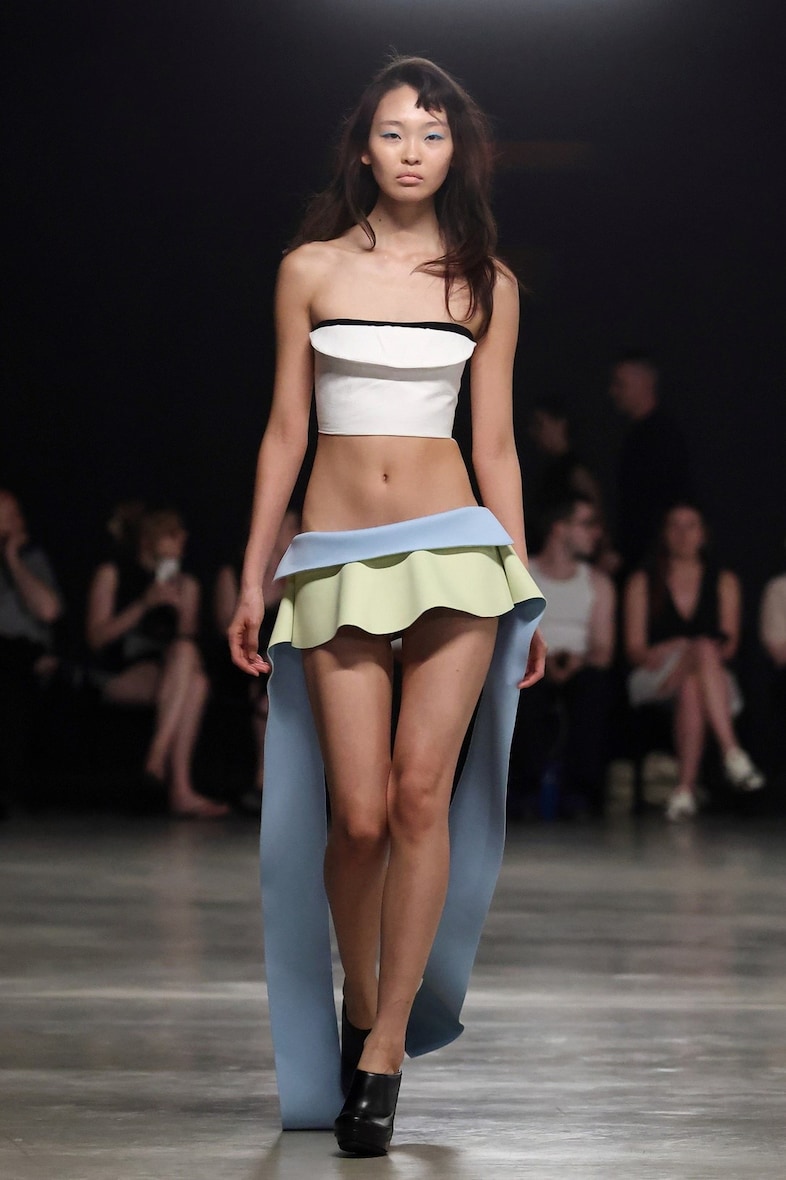
Sia Arnika is fast becoming Berlin’s breakout “It-girl” brand. In the last year, Arnika has dressed Charli xcx for her star-studded 32nd birthday party, Tyla at the recent Kids Choice Awards, and before then has considered Julia Fox one of her most loyal customers. This season, the German designer borrowed from another esoteric It-girl, Lana Del Rey, for the title of her SS26 collection Summer Time Sadness – but that’s where the comparisons stopped. Going even more left field than a Lana track, Arnika looked to the autobiographical work of Karl Ove Knausgård to summon the feeling of “long summer nights where time feels both endless and insufficient”. On the runway, this was translated to lots of beach-inspired clothing, like gingham swimsuits and green bikinis, while the more daytime-appropriate clothing came in the form of avant-garde structured shirts and cute day dresses. There was also plenty for the night time though, with standout looks coming via the ruffled mini skirts with long, thick tassels, and the towering baby doll heels that gave the models a run for their money.
in HTML format, including tags, to make it appealing and easy to read for Japanese-speaking readers aged 20 to 40 interested in fashion. Organize the content with appropriate headings and subheadings (h1, h2, h3, h4, h5, h6), translating all text, including headings, into Japanese. Retain any existing
tags from
Berlin Fashion Week SS26 street style50 Images
Much has been made of Berlin Fashion Week’s ascent in the last couple of years. With Fashion Council Germany – along with the help of the German state – now committed to pumping €4 million a season into the shows, there’s been a renewed interest in the bi-annual fashion week, which has steadily been making its mark over the past few seasons.
A main draw for a lot of attendees is Intervention, a curated day of shows from the Berlin-based agency Reference Studios. When speaking to agency founder Mumi Haiati about Intervention drawing guests to Berlin, the Reference boss is thankful, but sees the operation as much bigger than himself. “I’m flattered, but I also feel like this was exactly the mission,” he says. “For us it was important we create something that can be relevant for the world, to build an identity for Berlin, without being too homogenous. The city of Berlin came to us for that challenge.” And working alongside Germany’s governing fashion body, Reference and the FCG now have “a deep understanding of each other and a mutual goal: to put creativity first”, according to Haiati.
Outside of Intervention, the entire BFW schedule is packed full of young talent, like Central Saint Martins grad Andrej Gronau, who presented his sophomore collection last week; Berlin stalwart Sia Arnika, who continues her exploration into It-girl style; and Richert Beil, who presented a refined collection with a laser-like focus on craft. For all those and more, these were the best shows to come out of Berlin Fashion Week SS26.

As the opening act of this season’s Intervention, LUEDER SS26 introduced guests to the Palais am Funkturn, an impressive mid-century events space built by Bruno Grimmek and Werner Düttmann in 1957. One of the building’s main spaces – a cavernous ballroom with towering stained glass windows – was the perfect venue for Marie Lueder’s newest designs, which often feel ecclesiastic in their references. After AW25’s sojourn into sexier territory, Lueder returned to the more overtly medieval inspirations of past seasons – but SS26 was far from a regression. Inspired by the story of St George and the Dragon, the collection reimagined “ancient archetypes through the lens of present-day resistance, transformation, and psychic armour”. A stirring performance from Roman Ole began proceedings, then on the runway, the dragon was recast as a giant inflatable Venus flytrap, bringing the allegory into the domestic realm, while models walked the church-like space in diaphanous gowns and serf-coded knits. Piercing dragon eyes appeared on bikini bra cups, Hawaiian shirts were splattered with bleach and a collaboration with Ugg saw models walk the space in its ankle-high sheepskin boots.
Ottolinger Resort 202638 Images
After years and years at Paris Fashion Week, this season Berlin finally enticed Christa Bösch and Cosima Gadient to show up for their home city. Also a part of Reference Studios’ Intervention format, Ottolinger’s BFW catwalk was actually a Resort collection rather than SS26, suggesting they’ll probably pop back to Paris when the time comes this September. Despite that though, the duo left nothing on the table in the German capital, enlisting Kim Petras to open their Heidi collection, an ode to the cool, older sisters everywhere.
“Being the cooler older sister isn’t about being perfect,” read notes placed on seats at the show. “It’s about having lived – loved too hard, fallen harder, found her way back, and doing it all in a way that makes you believe you can too. She’s the one who broke the rules first – so you wouldn’t have to be afraid of breaking them.” Right on time, (or just a little behind schedule) rule-breaking pop star Petras opened in orange and grey knitted hotpants, her viral stomp very likely to have already graced your For You Page. Glimpses of an upcoming Nike collaboration (expected 2026) were layered under slinky cutout dresses, while the bulky, distressed leather jackets were a clear standout.

After an AW25 collection that leaned too heavily on of-the-moment, “indie sleaze” aesthetics, SF1OG was back on form with an offering inspired by “the fragile terrain of romance, walking the fine line between longing, obsession, and emotional decay.” Held in an active building site a stone’s throw from the famous Kurfürstendamm designer district, set designer John Andrews hung fabric-covered pillars from the ceiling, ones you had to deftly navigate to find your seat. The claustrophobia continued as models weaved their way through the hanging ornaments down the narrow runway, often centimetres from the onlooking guests. The show space had been designed to mimic the awkward intensity of teenage romance, and so had the clothes: an opening leather jacket look came torn and tattered, Sacred Heart motifs came black and emo, while ripped jeans and raw hems communicated an angsty, rebellious flare. Elsewhere, leather corsets colour-matched to their models’ skin were covered in excessive, angsty scribbles, as if a troubled teenager had taken a Sharpie to their bedroom wall, and arrows shot by Cupid rested as accessories strapped to models’ heads.

Andrej Gronau SS2619 Images
Central Saint Martins graduate Andrej Gronau presented his debut last season, a collection full of colourful knits in bold colours with a recurring star motif. For SS26, everything was elevated but still rendered in Gronau’s signature youthful style. A men’s white top with twisted ruching opened the show, and below were trousers with a drop-waist effect caused by some block panelling around the waist. A checked duster coat with cable knit legging followed, then pleated tennis skirts and cute cable knits. A red and white gingham print became a touchstone in the collection, cropping up on jackets, boxer shorts and a peplum skirt. Backstage after the show, Gronau revealed that the collection, Alpine Fiction, was inspired by an impromptu trip to the Alps, which made a lot of sense considering the subtle Bavarian flavour running through. Reimagining folk heritage “through a surreal, contemporary lens”, lederhosen were re-envisioned as roomy board shorts, narrow scarves looped around models’ necks and pussy-bows dotted on cashmere and slacks.

Richert Beil SS2615 Images
For their SS26 show, designers Jale Richert and Michele Beil brought guests to their new studio, a 135-year-old renovated pharmacy in Berlin’s Kreuzberg. With dusty floorboards and a very intimate seating plan, the show was a “reflection on beginnings and endings, on transformation and on the responsibility of creating something with meaning” according to show notes. Made during their move to the new space, Milieuschutz the collection is named after Milieuschutz the concept, a type of planning protection that some neighbourhoods have to protect their social character (not incidentally, Richert Beil’s new Kreuzberg studio is protected by Milieuschutz.) “The title itself references the legal protection of neighborhoods, but here it becomes a metaphor,” said the designers. “For protecting values, methods, and ideas that are at risk of being lost in the pace and surface of today’s fashion system.”
Though it may seem an arcane concept to non-Germans, on the runway this was translated to a focus on craft, or as Richert and Beil put it “keeping the poetry – in fabric, in form, in process – while evolving structure and clarity.” By far the label’s most technically impressive collection to date, the tailoring was of the highest level, latex coats bounced like supple leather, and graphics and logos were used in a considered and tasteful way.

Sia Arnika is fast becoming Berlin’s breakout “It-girl” brand. In the last year, Arnika has dressed Charli xcx for her star-studded 32nd birthday party, Tyla at the recent Kids Choice Awards, and before then has considered Julia Fox one of her most loyal customers. This season, the German designer borrowed from another esoteric It-girl, Lana Del Rey, for the title of her SS26 collection Summer Time Sadness – but that’s where the comparisons stopped. Going even more left field than a Lana track, Arnika looked to the autobiographical work of Karl Ove Knausgård to summon the feeling of “long summer nights where time feels both endless and insufficient”. On the runway, this was translated to lots of beach-inspired clothing, like gingham swimsuits and green bikinis, while the more daytime-appropriate clothing came in the form of avant-garde structured shirts and cute day dresses. There was also plenty for the night time though, with standout looks coming via the ruffled mini skirts with long, thick tassels, and the towering baby doll heels that gave the models a run for their money.
and integrate them seamlessly into the new content without adding new tags. Ensure the new content is fashion-related, written entirely in Japanese, and approximately 1500 words. Conclude with a “結論” section and a well-formatted “よくある質問” section. Avoid including an introduction or a note explaining the process.
